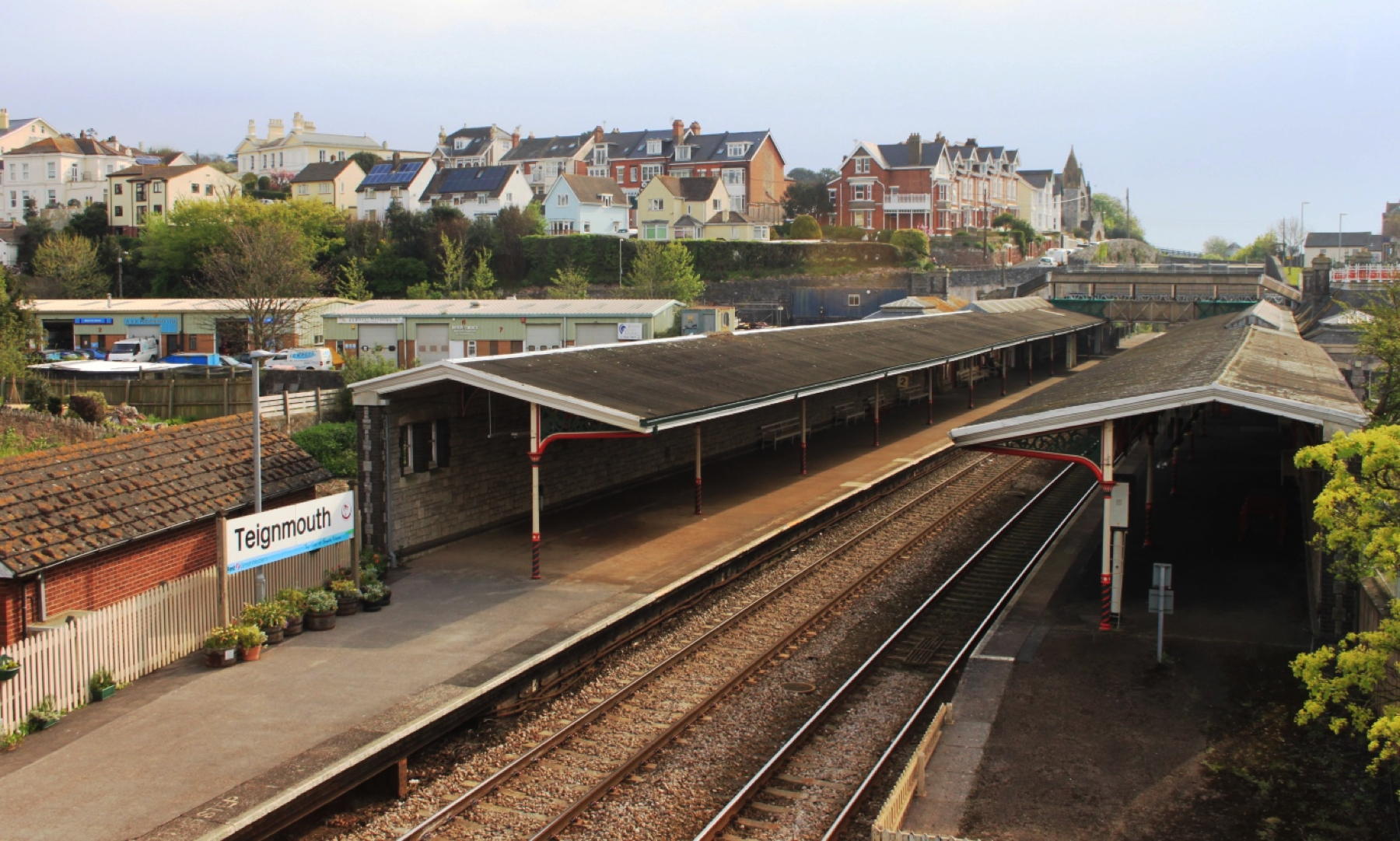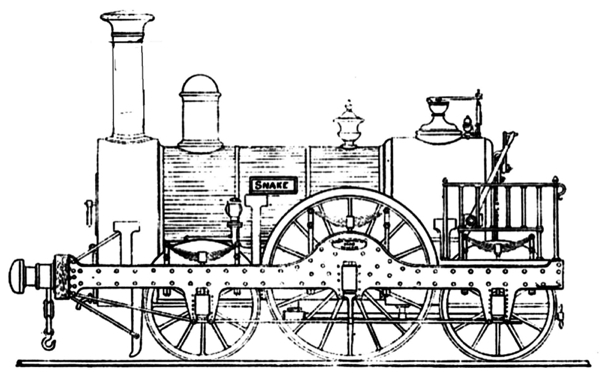South Devon Railway
Teignmouth
In which Joe says there is nothing to see here, and reviews some history instead.
Explorations: 25 June and 11 October 2018, and 28 June and 21 October 2019.
Journey: Paddington to Exeter St Davids, and St Davids to Teignmouth
-
OFTEN CITED REFERENCES
- Paul Garnsworthy, editor, Brunel's Atmospheric Railway, The Broad Gauge Society, 2013.
- Peter Kay, Exeter–Newton Abbot: a Railway History, Platform 5, 1991, and excerpts in Garnsworthy.
- Howard Clayton, The Atmospheric Railways, the author, 1966.
- Charles Hadfield, Atmospheric Railways, David and Charles, 1967.
- G.A. Sekon, A History of the Great Western Railway, Digby, Long, 1895.
The sixth engine house on the South Devon Railway was at Teignmouth, in property next to the station. Work on the building began at least three months after work at Dawlish. The railway to Teignmouth runs along the coast, with several tunnels built for a single broad-gauge track. Nearing the mouth of the River Teign, the railway curves away to the west through high ground. As built, there was a tunnel on each side of Teignmouth station, each of which was converted to open cut when the railway was double-tracked. The journey today turns away from the sea and runs mostly between high walls and the station buildings until it finally opens again beyond Teignmouth to a view of the broad, shallow Teign.
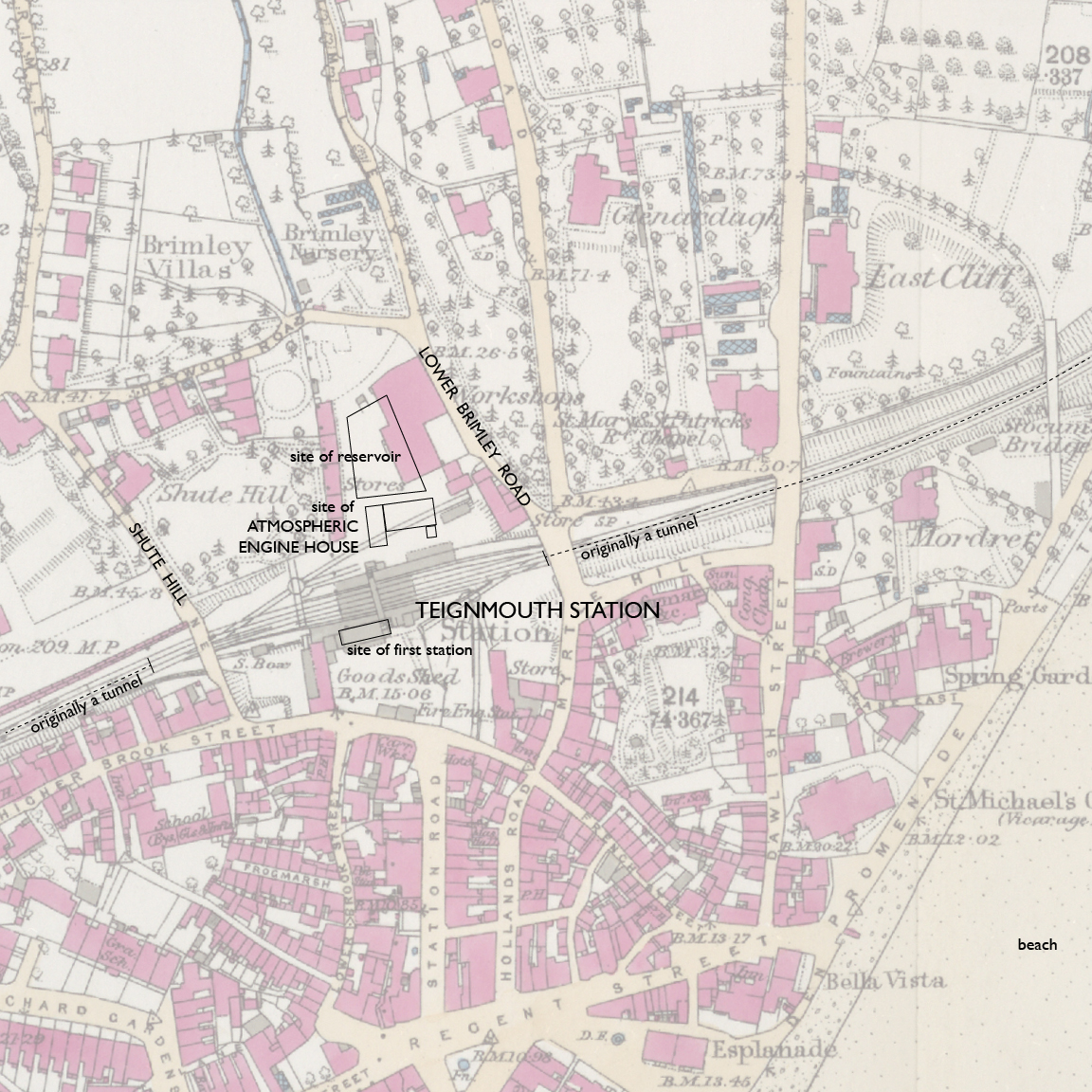
— Teignmouth station and engine house, Ordnance Survey 25-inch, 1890. CC BY-NC-SA 4.0 courtesy National Library of Scotland.
Annotations by Joseph Brennan.
Teignmouth is a port town, thefirst significant point for freight business on the SDR. The railway had property north of the station that was at first used for the atmospheric buildings. Once they were rendered useless for their purpose it was only a matter of time before they were demolished in 1856 to use the space for a freight yard. There is nothing left of the atmospheric structures today, not even so much as the slight ruins at Countess Wear and Turf. The OS map shows the property in use circa 1890 for railway sidings and storage rooms, with a turntable at the entrance.

— William Dawson, plan at Teignmouth, via Brunel's Atmospheric Railway.
William Dawson did not draw the station or engine house, preferring views of the coast. We do have the plan, which shows the location of the atmospheric buildings and the open reservoir. A stream called the Brimley Brook came down the hill through the property, providing water for the reservoir and the station itself. The turntable for locomotives was already there as in 1889. For many years there was another smaller turnplate on the south side, the size of one four-wheel wagon, with a track from it crossing the main line on the level to the north side.
A view from the Shute Hill bridge shows on the left where the atmospheric buildings were. After being used for many years for railway sidings and storehouses, the property is now in commercial use for motor vehicles, with simple modern storehouses.
The center of Teignmouth is off to the right (south), so the station house with the usual amenities has always been on that side. After the atmospheric was abandoned, a platform was built in 1848 along the north side track, reached by a footbridge. Passengers waiting for departures are the main users of station facilities, and most of those at Teignmouth were going toward Exeter or points beyond, but the station house was on the wrong side for them, or so it seemed. To correct the inconvenience, all trains coming out of the single-track tunnels were switched to the right-hand track through the station. In his book chapter on Teignmouth, Peter Kay comments, "To avoid any confusion the terms 'Up' and 'Down' will not be used, the platforms being referred to as 'the original platform' and 'the 1848 platform' instead."
Once the tunnels were daylighted in 1884, double track was available through the whole railway from Exeter to Newton Abbot (save one last point, Parson's Tunnel at Hole Head, doubled in 1905). With this, normal left-handed running began at Teignmouth. The station itself still included the original wooden "temporary" building, and although it was somewhat larger than those to the north, and had later additions, the overall result became the subject of ridicule. It was finally replaced by the present-day station in 1893-94, eliminating the last trace of atmospheric railway construction. The new station followed close on the end of broad gauge in 1892.
A contributor offered me two fine views of the station seen on an overcast day in 2013. Both look east from the down platform. These and the previous photograph show how the railway still seems walled in, even in the station area, which is within a wider space of this ground level on each side. I love the Victorian ironwork, and I love the paint colors given it at so many stations like this one.
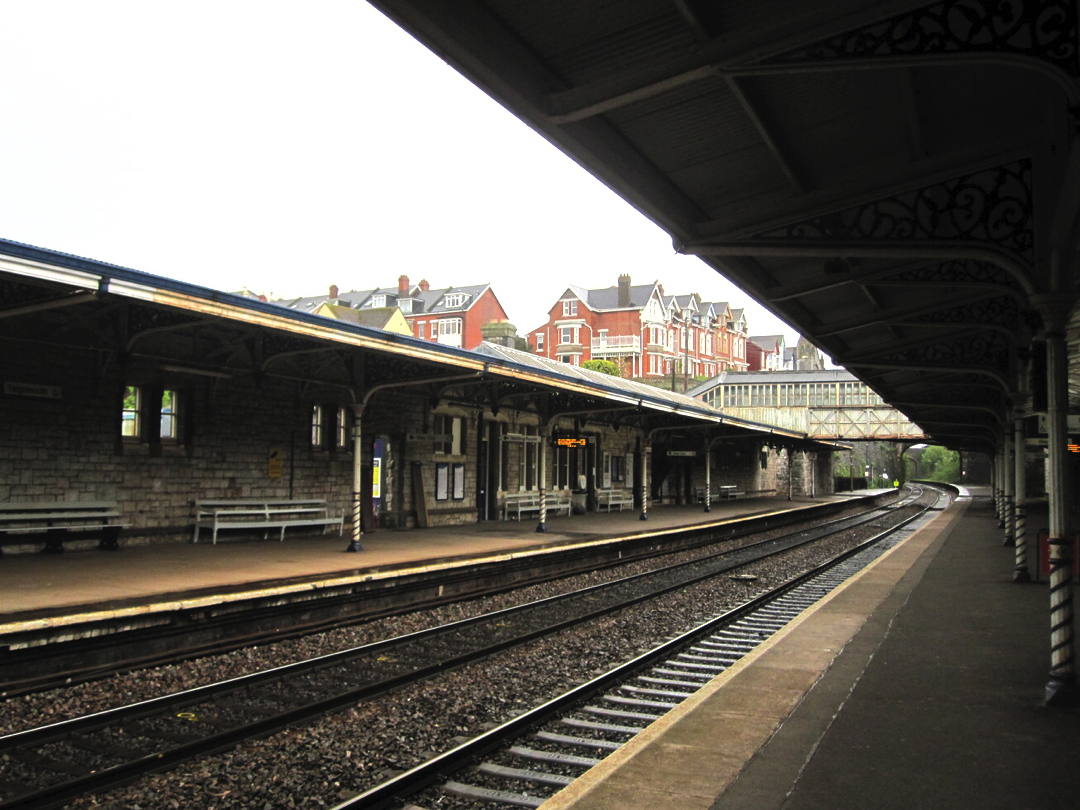
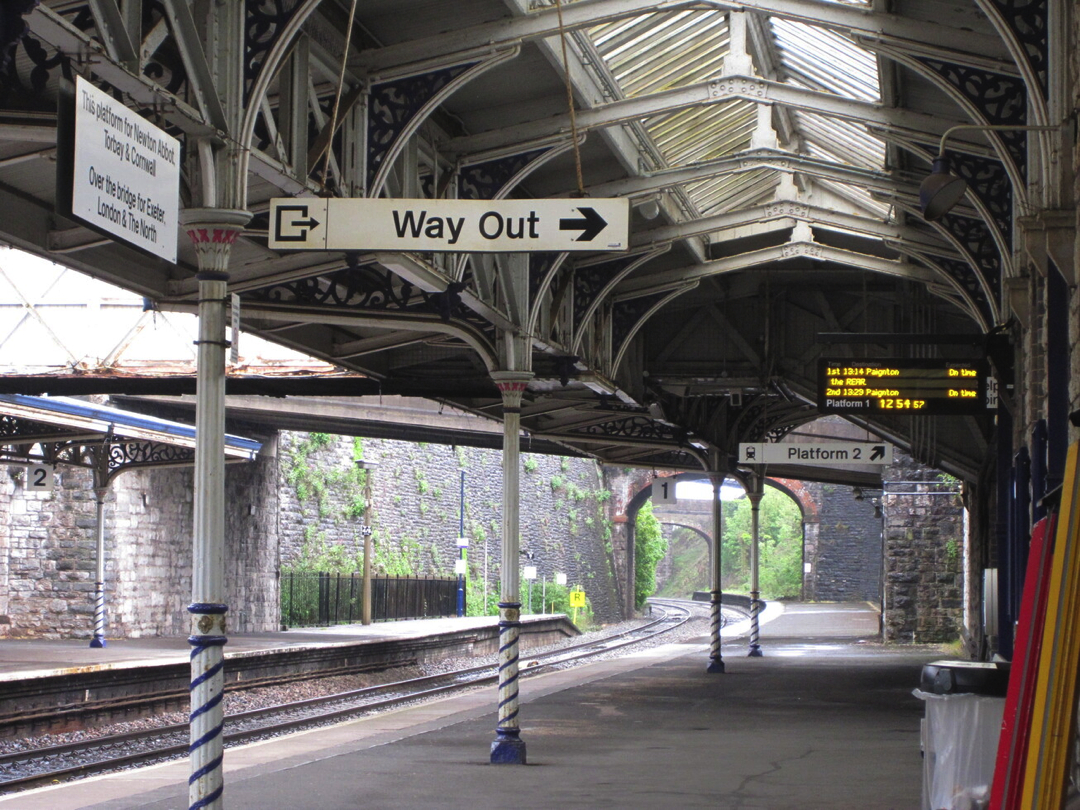
The pre-atmospheric South Devon Railway
I mentioned back on the Exeter St Davids page that the South Devon Railway's engineer Isambard Kingdom Brunel recommended to the company directors at the August 1844 meeting that their newly approved railway should be built for atmospheric operation. From Brunel's predictions the directors told the public that the railway would be open from Exeter to Teignmouth by July 1845. This was of course ridiculous, but no one knew.
A few months were spent negotiating with suppliers. It was not until December that Brunel requested bids for the engines, and January 1845 when he contracted for eight sets, three each from Boulton and Watt, and Rennie Brothers, and two from Maudsley. They were supposed to be ready to work by July, a very short deadline. The boilers were a separate contract, and so were the buildings that would house them. In his book Clayton notices that strong winds for four months in winter prevented tides from rising to their normal height, stopping many deliveries while ships rode at anchor. He adds that Hennet, the maker of the pipe, had difficulty casting them with the slot in them, and besides that Brunel decided in March 1845 to scrap the 13-inch pipe Hennet had made and use 15-inch instead, which caused Hennet to start over.
July 1845? Construction of the first three engine house buildings, namely Exeter, Countess Wear, and Turf, only began in June and the engines at those and Starcross and Dawlish were not installed and ready to start up until February and March 1847. The Teignmouth engine house was still being built. Its engine started in June, after a slight delay caused by the SDR neglecting to deliver coal.
In the meantime, by March 1846 track had been laid to a point along the river beyond Teignmouth, and the SDR directors decided to open and collect some income.
The early opening was made possible by the SDR's leasing of two steam locomotives from its investor the Great Western Railway. What they got were two of the first engines the GWR ever had, Snake and Viper, a unique order of two delivered in September 1838 from the Haigh Foundry. They were based on some idea of Brunel to reduce cylinder stroke speed, and described by Clayton as "curiosities" with "a train of gear wheels for communicating motion to the drive wheels, this being a continuous source of trouble." I don't know what that means. The GWR had at least the sense to hire Daniel Gooch as Locomotive Superintendent. Of these two oddities Gooch said, "I felt very uneasy about the working of these machines, feeling they would have enough to do to drive themselves along the road." He rebuilt them in 1839 to a more conventional design. While they were on the SDR they carried the names Teign and Exe respectively. At a cost of 2 shillings and sixpence per engine mile, they were much more expensive than Brunel's estimate of only 1 shilling per mile with atmospheric power.
Opening day was Saturday 30 May 1846, the start of Whit weekend. Clayton writes that "St Thomas's station at Exeter was beseiged. Up to 1,500 passengers were carried at a time, trains of 21 carriages being required for the purpose." At 12,000 per week for the first six months, passengers exceeded expectations. Sekon quotes receipts of £15,620 on operating expenses of £10,124.
There were two miscalculations, as Clayton mentions. The SDR had to pay £1,800 a year to run into St Davids, but it turned out that 90% of the passengers from Exeter used St Thomas, for the obvious reason that it was closer to town. Management were also surprised at the number of third-class tickets sold. "It never seems to have occurred to these rather stupid men," Clayton writes, "that many of their passengers who travelled third class did so because they preferred, on a line of such exciting scenic appearance and during the summer months, to ride in the open carriages." He wonders why the company never promoted the idea, especially during atmospheric operation when there would be no locomotive smoke. Instead they tried to increase revenue by reducing the number of third-class carriages.
In the first timetable, shown in Peter Kay's book, the journey from Exeter to Teignmouth was carded as 45 minutes, with stops at St Thomas (not shown), Starcross, and Dawlish. A note advises that coaches were available at Teignmouth not only for nearby Newton, but also for travel as far as Paignton and Plymouth, all of which happen to be places that the SDR would reach during the next five years.
The railway was extended to Newton, now Newton Abbot, on 31 December 1846, and Totnes on 20 July 1847. This was still before atmospheric operation, which never reached the latter station.
The atmospheric South Devon Railway
The leather valves for the 21-mile segment from Exeter to Newton, which had to be purchased from Samuda, were contracted in February 1845 and delivery was complete by September. They were then put away somewhere for about a year. The 15-inch pipes from Hennet were installed from December 1845 at Exeter to the end of track beyond Teignmouth in August 1846. Attaching the valves began later that year and was complete to Teignmouth by March 1847. The first piston carriage arrived on 25 February. By March test runs to Dawlish were in progress, and to Teignmouth in June. During this time the power of the engines and pumps was found unsatisfactory, and they were modified to provide enough vacuum in the 15-inch pipes.
Also during this time, the London and Croydon suspended atmospheric operation for six weeks in June and July 1846, to replace the valves with a different design. Brunel desperately spun this development at the next SDR directors' meeting as an advantage to them, by waiting for the L&CR to experiment with things! It was a heavier lift for him to report the Croydon abandoning atmospheric operation on 3 May 1847, when the South Devon was still getting the engine houses in order.
What Peter Kay calls the "ghost service" began on 16 August 1847 from Exeter to Teignmouth. Two atmospheric trains ran each way, on a timetable, stopping at stations, but not taking passengers. Brunel was still working out how to start trains with ropes (which was probably done at Teignmouth although there is no record). Kay quotes Woolmer's Gazette, a publication always critical of the venture, stating that "every day brings forth new obstacles, which are only overcome by fresh mechanical contrivances." There was some truth to it.
Monday, 13 September 1847, was the start of public atmospheric operation. Three new trains were added to the timetable, short runs providing extra service between Exeter and Teignmouth. They were slotted between the locomotive trains already operated to Newton and and Totnes. All trains made all stops. A week later some of the other trains were converted to atmospheric operation as far as Teignmouth, locomotives handling each of them between there and Newton, including the piston carriage. There was already a long stop at Newton, the only place where trains were scheduled to pass, so it was better to shunt the piston carriages there rather than delay trains at Teignmouth.
I will continue the atmospheric story in the next few pages, as we move farther down the line.
NOTES
The dates I give at the top are when I passed through Teignmouth and looked out the window at the station. Knowing that there was no trace of the atmospheric, I never did detrain and look around. My loss. It looks interesting in Google Streetview. For one thing there is a street named The Street with No Name, corner of Esplanade and Promenade. It has a standard street sign.
The tunnels around the station were a mixture of "covered ways" and true tunnels, the latter those that were opened out horizontally from the ends. I thought it simpler to write "tunnel" than spell out the portions that were of each type. For detail please see Peter Kay's book. Converting the west tunnel and two covered ways to open cut was completed in 1881. On the east side the arched "tunnel" included part built by cut and cover, nearer the station, and the rest as true tunnel. The two 2013 photographs show how high the ground is on the east side.
William Dawson described each painting as a view north or south of the line. It's a little confusing because "North of the Line" means a view looking toward the south from a viewpoint north of the line. Without splitting hairs about being precisely north and south, that is correct at Exeter. By the time you get to Starcross, "North of the Line" means looking toward the west from a viewpoint off shore. But that's nothing. At Teignmouth, the title is totally at odds with the compass, his "North of the Line" being a view from the south (which I omit since the atmospheric buildings are not visible). The plan likewise has south at the top, and that is why I show it upside down on this page. Dawson continued in this style to the end. If you are looking at his work in the book Brunel's Atmospheric Railway, try to keep this in mind.
TODAY'S ETYMOLOGY
Teignmouth is of course at the mouth of the Teign. The only surprise is that it is pronounced "tinmuth".
The river is called Teng in charter S 255 of King Æthelheard of the West Saxons in 739, in which he grants lands to Forthhere, bishop of Crediton, a place northwest of Exeter. The surviving copy is not original but scholars accept it as authentic. The name is probably meant to represent a short vowel like that in Teignmouth.
The grant to Leofric, S 1003, the year 1044, by King Eadweard (the Confessor), which I noted on the Dawlish page, also may be the first documentation of Teignmouth. In describing the boundaries, it starts as follows. The document switches from Latin to English at this point.
Ð sindo tha landgemæro. Ærest on Tenge muðan, upp and lang thæs fleotes on crampansteort ; and saw eft ongean be tham salternon on tha stræte on west healfe Michaheles cirician ; and swa norð eft oongean on tha stræt on the greatan dic ; thanon norð on gerihte on thone blindan stá...or
These are the land boundaries. First at Tenge mouth, up along the estuary to crampansteort ; and so back again by the salterns on the street on the west side of Michael's church ; and so north again on that street to the great dyke ; then north back right on to the blind well...This establishes the form Tengmouth with the name Teng and the usual "muth" in the second less stressed syllable. A saltern is a place where salt is extracted from evaporated water. The Teign estuary is tidal.
It also establishes a division of what is now Teignmouth that persisted for centuries. The dividing line was a stream called the Tame, now running underground. The writer of the Dawlish article, James Bridge Davidson, says that the otherwise unknown word crampansteort means an anchor point at the mouth of the Tame, near what is now New Quay. Its path upstream is under Teign Street, Bank Street, Wellington Street, Lower Brook Street, and toward St Michael's Church. West Teignmouth, once called "Teignmouth Regis" since it was not granted to Leofric by King Eadweard, has the Old Quay and was the important port with the larger population.
Teignmouth is not in the Domesday Book (1086) because it was divided, partly within DOVLES (Dawlish) and partly within TANTONE. The latter area included West Teignmouth and land north and west, which was an addition to Leofric's grant from King William (the Conqueror) in 1069, when he confirmed the grant from Eadweard, but changed it to specify that the grant was to the See of Exeter, of which Leofric was Bishop, not to Leofric personally. Outside modern Teignmouth this area is now Bishopsteignton, its name differentiating it from Kingsteignton, the next area to the west that remained a royal demesne until the thirteenth century. "Tantone" suggests a variant pronunciation from "teng", and it diverged further, such that the two "teignton" places are pronounced with "tain" and not "tin".
(The reference to King William's charter of 1069 is from Beatrix F. Cresswell's Teignmouth, Its History & Its Surroundings, Homeland Association, 1901. Cresswell wrote many books on Devon history, and from reading this one I would say she is fairly immune to passing along hearsay as fact. Yet I have admit to finding no source online for this charter. It could very well be an unpublished manuscript in the Cathedral or Guildhall libraries in Exeter, sources that she definitely used for some of the books.)
The river's name Teng is said to be of Celtic origin, and to mean "stream", putting it in the company of rivers named "river" (Avon, Exe, Esk). This is believable, but I cannot help but notice that in the ancient world the Phoenicians and then the Romans traded for tin with miners in what are now Devon and Cornwall. One of the mining areas was Dartmoor, where the Teign originates. The word "tin" is of Germanic origin, zinn in German and tin in Dutch, and a name in 739, under a Saxon king, could reasonably be Germanic. I have found no one else on the 'net who has suggested this derivation for the name of the river.
